Maritime history

Maritime history is the study of human interaction with and activity at sea. It covers a broad thematic element of
Maritime history is the broad overarching subject that includes
Historiography
Historians from many lands have published monographs, popular and scholarly articles, and collections of archival resources. A leading journal is International Journal of Maritime History, a fully refereed scholarly journal published twice a year by the International Maritime Economic History Association. Based in Canada with an international editorial board, it explores the maritime dimensions of economic, social, cultural, and environmental history.[4] For a broad overview, see the four-volume encyclopedia edited by John B. Hattendorf, Oxford Encyclopedia of Maritime History (Oxford, 2007). It contains over 900 articles by 400 scholars and runs 2900 pages.[5] Other major reference resources are Spencer Tucker, ed., Naval Warfare: An International Encyclopedia (3 vol. ABC-CLIO, 2002) with 1500 articles in 1231, pages, and I. C. B. Dear and Peter Kemp, eds., Oxford Companion to Ships and the Sea (2nd ed. 2005) with 2600 articles in 688 pages.[6]
Typically, studies of merchant shipping and of defensive navies are seen as separate fields.
One approach to maritime history writing has been nicknamed 'rivet counting' because of a focus on the minutiae of the vessel. However, revisionist scholars are creating new turns in the study of maritime history. This includes a post-1980s turn towards the study of human users of ships (which involves sociology, cultural geography, gender studies and narrative studies);[7] and post-2000 turn towards seeing sea travel as part of the wider history of transport and mobilities. This move is sometimes associated with Marcus Rediker and Black Atlantic studies, but most recently has emerged from the International Association for the History of Transport, Traffic and Mobilities (T2M)[8]
- See also: Historiography related articles below
Prehistoric times
Watercraft such as rafts and boats have been used far into pre-historic times and possibly even by Homo erectus more than a million years ago crossing straits between landmasses.[9][10]
Little evidence remains that would pinpoint when the first seafarer made their journey. We know, for instance, that a sea voyage had to have been made to reach Greater Australia (Sahul) c. 50,000 or more years ago. Functional maritime technology was required to progress between the many islands of Wallacea before making this crossing. We do not know what seafaring predated the milestone of the first settling of Australia.[11][12]: 26 One of the oldest known boats to be found is the Pesse canoe, and carbon dating has estimated its construction from 8040 to 7510 BCE. The Pesse canoe is the oldest physical object that can date the use of watercraft, but the oldest depiction of a watercraft is from Norway. The rock art at Valle, Norway depicts a carving of a more than 4 meter long boat and it is dated to be 10,000 to 11,000 years old.[13]
Ancient times

Throughout history sailing has been instrumental in the development of civilization, affording humanity greater mobility than travel over land, whether for trade, transport or warfare, and the capacity for fishing. The earliest depiction of a maritime sailing vessel is from the

The
By 1000 BCE, Austronesians in Island Southeast Asia were already engaging in regular maritime trade with China, South Asia, and the Middle East, introducing sailing technologies to these regions. They also facilitated an exchange of cultivated crop plants, introducing Pacific coconuts, bananas, and sugarcane to the Indian subcontinent, some of which eventually reached Europe via overland Persian and Arab traders.[23][24] A Chinese record in 200 AD describes one of the Austronesian ships, called kunlun bo or k'unlun po (崑崙舶, lit. "ship of the Kunlun people"). It may also have been the "kolandiaphonta" known by the Greeks.[25]: 347 It has 4–7 masts and is able to sail against the wind due to the usage of tanja sails. These ships reached as far as Madagascar by ca. 50–500 AD and Ghana in the eighth century AD.[26][27][28]
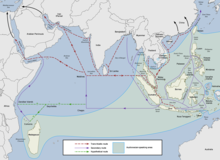
Northern European
was used on the waters of the Red Sea, Indian Ocean, and Persian Gulf.China started building sea-going ships in the 10th century during the
Water was the cheapest and usually the only way to transport goods in bulk over long distances. In addition, it was the safest way to transport commodities.
The mariner's astrolabe was the chief tool of Celestial navigation in early modern maritime history. This scaled down version of the instrument used by astronomers served as a navigational aid to measure latitude at sea, and was employed by Portuguese sailors no later than 1481.[36]
The precise date of the discovery of the magnetic needle compass is undetermined, but the earliest attestation of the device for
The oldest known map is dated back to 12,000 BC; it was discovered in a Spanish cave by Pilar Utrilla.[39] The early maps were oriented with east at the top. This is believed to have begun in the Middle East.[39] Religion played a role in the drawing of maps. Countries that were predominantly Christian during the Middle Ages placed east at the top of the maps, in part due to Genesis, "the Lord God planted a garden toward the east in Eden".[39] This led to maps containing the image of Jesus Christ, and the garden of Eden at the top of maps.[39] The latitude and longitude coordinate tables were made with the sole purpose[dubious ] of praying towards Mecca.[39] The next progression of maps came with the portolan chart. This was the first type of map that labeled North at the top and was drawn proportionate to size. Landmarks were drawn in great detail.[39]
Ships and vessels
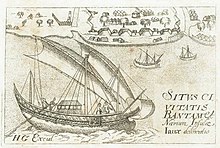
Various ships were in use during the
Arab age of discovery
The
Apart from the
Control of sea routes dictated the political and military power of the Islamic nation.[45] The Islamic border spread from Spain to China. Maritime trade was used to link the vast territories that spanned the Mediterranean Sea to the Indian Ocean. The Arabs were among the first to sail the Indian Ocean.[46] Long-distance trade allowed the movement of "armies, craftsmen, scholars, and pilgrims".[47] Sea trade was an important factor not just for the coastal ports and cities like Istanbul, but also for Baghdad and Iraq, which are further inland. Sea trade enabled the distribution of food and supplies to feed entire populations in the middle east. Long distance sea trade imported raw materials for building, luxury goods for the wealthy, and new inventions.
Hanseatic League

The
The 15th century saw the climax of Lübeck's hegemony. (
Italian maritime republics
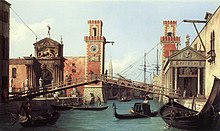
The
, are also considered maritime republics; in certain historical periods, they had no secondary importance compared to some of the better known cities.Uniformly scattered across the Italian peninsula, the maritime republics were important not only for the history of navigation and commerce: in addition to precious goods otherwise unobtainable in Europe, new artistic ideas and news concerning distant countries also spread. From the 10th century, they built fleets of ships both for their own protection and to support extensive trade networks across the Mediterranean, giving them an essential role in reestablishing contacts between Europe, Asia, and Africa, which had been interrupted during the early Middle Ages. They also had an essential role in the Crusades and produced renowned explorers and navigators such as Marco Polo and Christopher Columbus.[55]
Over the centuries, the maritime republics — both the best known and the lesser known but not always less important — experienced fluctuating fortunes. In the 9th and 10th centuries, this phenomenon began with Amalfi and Gaeta, which soon reached their heyday. Meanwhile, Venice began its gradual ascent, while the other cities were still experiencing the long gestation that would lead them to their autonomy and to follow up on their seafaring vocation. After the 11th century, Amalfi and Gaeta declined rapidly, while Genoa and Venice became the most powerful republics. Pisa followed and experienced its most flourishing period in the 13th century, and Ancona and Ragusa allied to resist Venetian power. Following the 14th century, while Pisa declined to the point of losing its autonomy, Venice and Genoa continued to dominate navigation, followed by Ragusa and Ancona, which experienced their golden age in the 15th century. In the 16th century, with Ancona's loss of autonomy, only the republics of Venice, Genoa, and Ragusa remained, which still experienced great moments of splendor until the mid-17th century, followed by over a century of slow decline that ended with the Napoleonic invasion.
Somali maritime enterprise
During the
In the
Age of Discovery
The

Richard Hakluyt was an English writer, and is principally remembered for his efforts in promoting and supporting the settlement of North America by the English through his works, notably Divers Voyages Touching the Discoverie of America (1582) and The Principal Navigations, Voiages, Traffiques and Discoueries of the English Nation (1598–1600).
European expansion
Although Europe is the world's second-smallest continent in terms of area, it has a very long coastline, and has arguably been influenced more by its maritime history than any other continent. Europe is uniquely situated between several navigable seas and intersected by navigable rivers running into them in a way which greatly facilitated the influence of maritime traffic and commerce.
When the
European colonization
In 1492,

From its very outset, Western colonialism was operated as a joint public-private venture. Columbus' voyages to the Americas were partially funded by Italian investors, but whereas the Spanish state maintained a tight rein on trade with its colonies (by law, the colonies could only trade with one designated port in the mother country, and treasure was brought back in special
In the
Ming Maritime world
Zheng He voyages
In the 15th century, before the European Age of Discovery began, the Chinese Ming Dynasty carried out a maritime operation that, like the European's late expeditions, was primarily carried out to expand power, increase trade, and in some instances forcibly subdue local populations.[65]
In 1405 Zheng He, a Muslim eunuch, was ordered by the Ming dynasty to lead a fleet of over 27,000 sailors and anywhere between 62[66] and 300 ships,[65] beginning a period of expedition which would last 33 years.[65][66] During his seven voyages, Zheng He visited over 30 countries spread out across the Indian Ocean. Under Emperor Yongle, this naval undertaking served primarily as a deliverer of letters demanding tribute and allegiance to the middle kingdom; gifts were the first approach to gaining a country's favor, but if circumstances required it Zheng He's fleet would resort to violence.[66][65] The result was a successful connection to 48 new tribute states and an influx of over 180 new trade goods; many were gifts.[66] These expeditions expanded China's diplomatic supremacy of the region and strengthened their economic ties in the area. When these expeditions ended, China's maritime strength diminished and lacked a powerful navy for centuries after.[66]
Other Ming Maritime Activity
The end of the imperially-sponsored voyages, however, in no way meant that Ming people no longer put to sea. Merchants, pirates, fishermen, and others depended on boats and ships for their livelihood, and immigration to Southeast Asia, both permanent and temporary, continued throughout Ming times.[67] Because Chinese and Chinese immigrants to Southeast Asia were the main players in commerce in the South China Sea, Chinese merchants and ships were critical to the Spanish trade in Manila. Not only did Chinese merchants supply the goods the Spanish bought with their American silver, but Chinese shipbuilders built the famous galleons that carried those goods and that silver back and forth across the Pacific twice a year.[68]
Clipper route
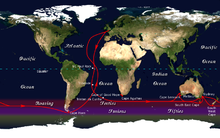
During this time, the
End of exploration
The
Age of Sail
The Age of Sail originates from ancient seafaring exploration, during the rise of ancient civilizations. Including
In the modern western countries, the European "Age of Sail" is the period in which
Notable individuals


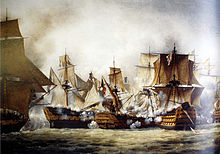
Spanish and English Armadas

The
The Spanish Armada consisted of about 130 warships and converted merchant ships. After forcing its way up the
The Spanish Armada was blown north up the east coast of England and in a hasty strategic move, attempted a return to Spain by sailing around Scotland and out into the Atlantic, past Ireland. But very severe weather destroyed a portion of the fleet, and more than 24 vessels were wrecked on the north and western coasts of Ireland, with the survivors having to seek refuge in Scotland. Of the Spanish Armada's initial complement of vessels, about 50 did not return to Spain. However, the loss to Philip's Royal Navy was comparatively small: only seven ships failed to return, and of these only three were lost to enemy action.
The
Spain's rebuilt navy had quickly recovered and exceeded its pre-Armada dominance of the sea, until defeats by the Dutch fifty years later marked the beginning of its decline. With the peace, the English were able to consolidate their hold on Ireland and make a concerted effort to establish colonies in North America.
North American maritime
The
The
Jonathan Haraden was a privateer during the American Revolution, being the first lieutenant of the sloop-of-war Tyrannicide, fourteen guns. On board for two years, he captured many prizes, becoming her commander in 1777.

Triangular trade
In the 17th, 18th, and 19th centuries a network of maritime trade formed in the Atlantic, connecting Europe, Africa, and the Americas through a triangular trade of African slaves, sugar/molasses, and rum.[74] This maritime trade route would enrich Europe and the Americas while also pulling both deeper into the slave trade.[75]
European merchants would buy slaves from African slavers, transporting these slaves to their sugar plantations in the Caribbeans, where the sugar/molasses they produced would be shipped to British North America and distilled into rum where it would be consumed in the colonies and sent to Europe.[74] In some models of triangular trade, the Colonies take Europe's place, and the model of trade shifts to Slaves from Africa to the Caribbean, sugar and molasses go to New England, and the rum/other finished goods would be sold in Africa to get more slaves.[76] Both of these models are not restricted to sugar trade; tobacco, cotton, and other plantation based raw materials take the place of sugar, and its derivatives.
Piracy in the Atlantic Ocean
During the Age of Discovery, key trade routes to the new world formed in the Caribbean and the Atlantic Ocean. With this concentrated area of trade, piracy was a significant maritime hazard in the 16th, 17th and 18th centuries. Some nations would use pirates to sabotage their rivals, going as far as supplying and recognizing them as legitimate.[77][78] Eventually, powers like the English and Dutch implemented strong anti-piracy tactics to strengthen their trade empires in the 18th century.[77]
In the 16th and 17th century Caribbean, the trading of slaves, precious metals, and raw materials all fell prey to piracy.[79] Pirates would raid forts, and attack ships at sea to get possession of merchants material wealth. In some cases, pirates would tie themselves to a maritime power like the British and aid them by raiding rival nations like the Spanish and leaving British trade unmolested.[78] In areas like Jamaica, some pirates were friendly with the British and would remain on the fringes of the colony. Some of these pirates were accepted by British colonial governors.[78]
The English and Dutch had created extensive trade empires during the 17th and 18th century and saw pirates as a barrier to their continued growth. English began building a codification for piracy, which started a war against pirates that lasted from the 1670s ending in the 1720s. During this time the English would develop a ship called the Jamaica Sloops which were better at fending off piracy.[79] In the late 1600s, the British began building up their navy and were able to put an end to most piracy by the 1720s violently, only isolated individual instances persisted.
Life at sea
Shipping, whether of cargo or passengers, is a business and the duties of a ship's captain reflect that. A captain's first duty was to the ship's owner and often the captain was encouraged to buy into the business with at least a one eighth share of the ship. A captain's second duty was to the cargo itself followed thirdly by the crew.
Crew were broken into two shifts that served four hour alternating watches often with all hands jointly serving the noon to 4:00 watch. American ships would commonly alternate watches with the addition of a two-hour dog watch. Work for sailors during their shift consisted primarily of general ship maintenance, washing, sanding, painting and repairs from general wear and tear or damage from storms. General ship operations like raising and lowering the anchor or furling and unfurling sails were done as needed. During the off shift hours, sailors could take care of their personal chores, washing and repairing clothes, sleeping and eating. Leisure time could was often spent reading, writing in journals, playing an instrument, wood carving or fancy rope work. The American Seaman's Friend Society in New York City would loan boxes of books to ships for sailor's use.[80]
Life aboard ship for immigrant travelers was much harsher and sometimes deadly. Ship owners would pack as many people as they could on board to maximize profits and little government oversight existed to ensure they received proper care during the voyage. British immigrant ships would often show less care to the passengers than criminals on prison ships to Australia. In 1803 the Passenger Vessel Act in Britain limited occupancy to one person per two tons of the ship's register. America issue stricter laws in 1819 limiting ships to a 1 to 5 ratio with fine levied should an overcrowded ship arrive at port. The Act of Feb. 1847 further increased the amount of space granted to passengers with the confiscation of a ship as the penalty for overcrowding.[81]
War of 1812

Challenger Expedition
HMS Challenger, built in 1858, undertook the first global marine research expedition called the Challenger expedition in 1872. To enable her to probe the depths, all but two of Challenger's guns had been removed and her spars reduced to make more space available. Laboratories, extra cabins and a special dredging platform were installed. She was loaded with specimen jars, alcohol for preservation of samples, microscopes and chemical apparatus, trawls and dredges, thermometers and water sampling bottles, sounding leads and devices to collect sediment from the sea bed and great lengths of rope with which to suspend the equipment into the ocean depths. In all she was supplied with 181 miles (291 km) of Italian hemp for sounding, trawling and dredging. As the first true oceanographic cruise, the Challenger expedition laid the groundwork for an entire academic and research discipline.
End of the sail
Like most
Submarines
The
Age of steam
Steam was first applied to boats in the 1770s. With the advent of economical
Rise of steam vessels
Steamships gradually replaced sailing ships for commercial shipping in the 19th century – mostly through the latter part of the century. Paradoxically, steam supported sail, by providing tugs that could speed the arrival of ships that would otherwise often be windbound in anchorages close to their point of departure or destination. Larger sailing vessels could be built for bulk cargoes, as the availability of tugs meant that they could be docked efficiently. Steam "donkey engines" enabled these larger ships to work with smaller crews, being used for hoisting large sails and generally doing the heavy work on the ship.[83]: 7–19, passim
Steam technology required a number of developmental steps to be able to compete with sail propulsion. Better materials and designs were needed for the boilers that ran at the higher pressures that allowed the increases in fuel efficiency from, first, compound engines (successfully used in
Whilst the technology steadily improved, sail remained the most economical choice for ship-owners who wished to make a good return on the capital they had invested. Steam was an option only for a limited number of trades until the 1860s, focusing on routes requiring scheduled services and/or reliable average speeds on a voyage – and only where the customer was prepared to pay the higher costs involved. Most of this was passenger transport and mail contracts. Only when the much more fuel efficient triple expansion engine had become common (by the 1890s) were all shipping routes fully commercially viable for steamers.[83]: 7-19
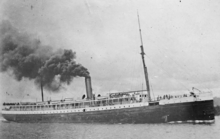
In 1880, the American passenger steamer Columbia became the first ship to utilize the dynamo and incandescent light bulb. Furthermore, Columbia was the first structure besides Thomas Edison's laboratory in Menlo Park, New Jersey to use the incandescent light bulb.[88][89][90]
Greek War of Independence
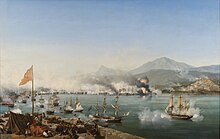
The Greek War of Independence was a successful war waged by the Greeks to win independence for Greece from the Ottoman Empire. Success at sea was vital for the Greeks. If they failed to counter the Ottoman Navy, it would be able to resupply the isolated Ottoman garrisons and land reinforcements from the
1850 to the end of the century
Most warships used steam propulsion until the advent of the gas turbine. Steamships were superseded by diesel-driven ships in the second half of the 20th century.
The
David Farragut was the first senior officer of the United States Navy during the American Civil War. He was the first rear admiral, vice admiral, and full admiral of the Navy. He is remembered in popular culture for his possibly apocryphal order at the Battle of Mobile Bay, usually paraphrased: "Damn the torpedoes, full speed ahead!".[91]

Raphael Semmes was an officer in the United States Navy from 1826 to 1860 and the Confederate States Navy from 1860 to 1865. During the American Civil War he was captain of the famous commerce raider CSS Alabama, taking a record fifty-five prizes. Late in the war he was promoted to admiral and also served briefly as a brigadier general in the Confederate States Army.
In Italy,
Again in America,
Garrett J. Pendergrast was an officer in the United States Navy during the American Civil War. He commanded USS Boston during the Mexican–American War in 1846. In 1856, he commissioned USS Merrimack, the ship that would later become CSS Virginia.
Lewis Nixon was a shipbuilding executive, naval architect, and political activist. Nixon graduated first in his class from the Naval Academy in 1882 and was sent to study naval architecture at the Royal Naval College where, again, he graduated first in the class in 1885. In 1890, with help from assistant naval constructor David W. Taylor, he designed the Indiana-class battleships which included USS Indiana, USS Massachusetts and USS Oregon.
20th century
In the 20th century, the
Maritime events of World War I

At the start of the war, the German Empire had cruisers scattered across the globe. Some of them were subsequently used to attack Allied merchant shipping. The British Royal Navy systematically hunted them down, though not without some embarrassment from its inability to protect allied shipping. For example, the detached light cruiser SMS Emden, part of the East-Asia squadron stationed at Tsingtao, seized or destroyed 15 merchantmen, as well as sinking a Russian cruiser and a French destroyer. However, the bulk of the German East-Asia squadron – consisting of the armoured cruisers SMS Scharnhorst and SMS Gneisenau, light cruisers SMS Nürnberg and SMS Leipzig and two transport ships – did not have orders to raid shipping and was instead underway to Germany when it was lost at the Battle of the Falkland Islands in December 1914.[93]
Soon after the outbreak of hostilities, Britain initiated a naval blockade of Germany, preventing supplies from reaching its ports. The strategy proved effective, cutting off vital military and civilian supplies, although this blockade violated generally accepted international law codified by international agreements.[94][95] A blockade of stationed ships within a three-mile (5 km) radius was considered legitimate,[94] however Britain mined international waters to prevent any ships from entering entire sections of ocean,[96] causing danger to even neutral ships.[97] Though there was limited response to this tactic, some[98] expected a better response for German's aim with its unrestricted submarine warfare.[99][100]
German U-boats attempted to cut the supply lines between North America and Britain.[101] The nature of submarine warfare meant that attacks often came without warning,[102] giving the crews of the merchant ships little hope of survival.[103][104] After the infamous sinking of the passenger ship RMS Lusitania in 1915, Germany promised not to target passenger liners. In 1916 the United States launched a protest over a cross-channel passenger ferry sinking, Germany modified its rules of engagement. Finally, in early 1917 Germany adopted a policy of unrestricted submarine warfare, realizing the Americans would eventually enter the war. Germany sought to strangle Allied sea lanes before the U.S. could transport a large army overseas.
The U-boat threat lessened in 1917, when merchant ships
The First World War also saw the first use of
Maritime events of World War II
Battle of the Atlantic


In the North Atlantic, German U-boats attempted to cut supply lines to the United Kingdom by sinking merchant ships. In the first four months of the war they sank more than 110 vessels. In addition to supply ships, the U-boats occasionally attacked British and Canadian warships. One U-boat sank the British carrier HMS Courageous, while another managed to sink the battleship HMS Royal Oak in her home anchorage of Scapa Flow.
In the summer of 1941, the Soviet Union entered the war on the side of the Allies. Although the Soviets had tremendous reserves in manpower, they had lost much of their equipment and manufacturing base in the first few weeks following the German invasion. The Western Allies attempted to remedy this by sending
Following the entry of the United States into the war in December 1941, U-boats sank shipping along the
The turning point of the
, and several destroyers.Pacific War
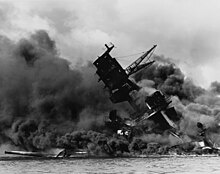
The

Island hopping was the key strategy to bypass heavily fortified Japanese positions and instead concentrate the limited Allied resources on strategically important islands that were not well defended but capable of supporting the drive to the main islands of Japan. This strategy was possible in part because the Allies used submarine and air attacks to blockade and isolate Japanese bases, weakening their garrisons and reducing the Japanese ability to resupply and reinforce. Most Japanese soldiers killed in the Pacific died of starvation, and Japan used its submarine fleet to try to resupply them.
Hard-fought battles on the
Latter half of the 20th century
In the latter half of the 20th century, various vessels, notably aircraft carriers, nuclear submarines, and nuclear-powered icebreakers, made use of nuclear marine propulsion. Sonar and radio augmented existing navigational technology.
Various blockades were set up in international action. Egypt blockaded of the Straits of Tiran from 1948 to 1956 and 1967. The United States set up a blockade of Cuba during the Cuban Missile Crisis in 1962. The Israelis set up a sea blockade of the Gaza Strip since the outbreak of the Second Intifada (2000) and up to the present. The Israeli blockades of some or all the shores of Lebanon at various times during the Lebanese Civil War (1975–1990), the 1982 Lebanon War, and the South Lebanon conflict (1985–2000)—resumed during the 2006 Lebanon War.
Cuban Missile Crisis

The Cuban Missile Crisis was seen as an event that brought the U.S. closest to nuclear war and nearly the end of human existence. The event was on October the 22, 1962 during the presidency of John F. Kennedy. It also happened over a 13-day period.[112] The nuclear power of the United States had a hand in why this event occurred. From this situation, the country learned that nuclear power does not have a lot of influence in politics.[113] The soviet leader, Klrushchv, was the first to have his missiles fall back. At the time, it did not look like the United States was going to do the same. The U.S. did not back down because an American plane had been shot down in Cuba during the event.[114] The blockade ended when the two powers resolved the issue peacefully.[115]
Gulf of Tonkin Incident
The
Falklands War
In 1982, the Falklands War was a war over the Falkland Islands with Argentina. This was said to be a very desperate war between Britain and Argentina.
Panama canal handover
Though controversial within the United States, a process of handing the
21st century
Since the turn of the millennium, the construction of stealth ships have occurred. These are ships which employs stealth technology construction techniques in an effort to ensure that it is harder to detect by one or more of radar, visual, sonar, and infrared methods. These techniques borrow from stealth aircraft technology, although some aspects such as wake reduction are unique to stealth ships' design.
Some of the major social changes of this period include women becoming admirals in defensive navies, being allowed to work on submarines, and being appointed captains of cruise ships.[121]
Arctic Resources Race

As of March 2020, global superpowers are currently in competition of laying claim to both regions of the Arctic Circle and shipping routes that lead directly into the Pacific and Atlantic oceans from the North Pole. Extensive access to the sea routes of the North Pole would allow, for example, save thousands of kilometers in distance from Europe to China.[122] Most prominently, claims to territory in the Arctic Circle would guarantee a plethora of resources; some including: oil, gas, minerals, and fish.[123]
Piracy
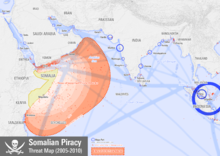
Seaborne piracy against transport vessels remains a significant issue (with estimated worldwide losses of US$13 to $16 billion per year),[124][125] particularly in the waters between the Red Sea and Indian Ocean, off the Somali coast, and also in the Strait of Malacca and Singapore, which are used by over 50,000 commercial ships a year.
Modern pirates favor small boats and taking advantage of the small number of crew members on modern cargo vessels. They also use large vessels to supply the smaller attack/boarding vessels. Modern pirates can be successful because a large amount of international commerce occurs via shipping. Major shipping routes take cargo ships through narrow bodies of water (such as the Gulf of Aden and the Strait of Malacca) making them vulnerable to be overtaken and boarded by small motorboats.[126][127] Other active areas include the South China Sea and the Niger Delta. As usage increases, many of these ships have to lower cruising speeds to allow for navigation and traffic control, making them prime targets for piracy.
The International Maritime Bureau (IMB) maintains statistics regarding pirate attacks dating back to 1995. Their records indicate hostage-taking overwhelmingly dominates the types of violence against seafarers. For example, in 2006, there were 239 attacks, 77 crew members were kidnapped and 188 taken hostage but only 15 of the pirate attacks resulted in murder.[128] In 2007 the attacks rose by 10% to 263 attacks. There was a 35% increase on reported attacks involving guns. Crew members that were injured numbered 64 compared to just 17 in 2006.[129] That number does not include hostages/kidnapping where they were not injured.
Modern definitions of piracy include the following acts:
- Boarding
- Extortion
- Hostage taking
- Kidnapping of people for ransom
- Murder
- Robbery
- Sabotage resulting in the ship subsequently sinking
- Seizureof items or the ship
- Shipwrecking done intentionally to a ship
See also
General
- Atlantic history
- Atlantic World
- Bibliography of early U.S. naval history
- Bibliography of 18th–19th century Royal Naval history
- Congo River
- History of the Royal Navy
- History of whaling
- Indian maritime history
- List of museum ships
- List of former museum ships
- List of naval battles
- Maritime history of Colonial America
- Maritime history of Europe
- Maritime museum
- Maritime timeline
- Maritime transport
- Military history
- Ming treasure voyages
- Naval history
- Niger River
- Sailortowns
- Ships of ancient Rome
- Timeline of maritime migration and exploration
Historiography articles
- American Neptune, a scholarly journal
- Atlantic history, historiography of the Atlantic region
- Frank C. Munson Institute of American Maritime History
- International Commission for Maritime History
- North American Society for Oceanic History
References
Citations and notes
- ^ "Worldwide Maritime Logistics Supply Chain Jobs". Archived from the original on 2017-10-27. Retrieved 2014-02-09.
- ^ John B. Hattendorf, editor in chief, Oxford Encyclopedia of Maritime History, (Oxford, 2007), volume 1, introduction.
- ^ Joshua M. Smith, “Toward a Taxonomy of Maritime Historians,” International Journal of Maritime History XXV:2 (December, 2013), 1-16.
- ^ See IJMH website Archived 2014-07-17 at the Wayback Machine
- ^ It is online at many libraries
- ^ It is online at many libraries
- ^ This began with the Maritime History Group,Working men who got wet: Proceedings of the fourth conference of the Atlantic Canada Shipping Project, July 24-July 26, 1980, (Memorial University of Newfoundland, St John, 1980)
- ^ See Yearbooks for 2009–2012, especially in the 2009 volume, article by Gijs Mom, Colin Divall and Peter Lyth, "Towards a Paradigm Shift? A Decade of Transport and Mobility History," t2m.org[permanent dead link]
- ^ "Ancient voyaging in Near Oceania". Te Ara Encyclopedia of New Zealand – Te Ara Encyclopedia of New Zealand. 2019-02-20. Retrieved 2021-08-18.
- ^ Vaucher, Jean (2012-01-08). "Prehistoric Craft". Université de Montréal. Retrieved 2021-08-18.
- ISBN 9780191590535.
- ISBN 978-0-19-992507-0.
- S2CID 234809731.
- ^ Carter, Robert "Boat remains and maritime trade in the Persian Gulf during the sixth and fifth millennia BC"Antiquity Volume 80 No.307 March 2006 [1]
- ISBN 0-8018-5130-0.
- PMID 27453633.
- S2CID 129923666.
- ISBN 978-0731521326.)
{{cite book}}: CS1 maint: location missing publisher (link - ISBN 9781920942854.
- ^ Hatshepsut oversaw the preparations and funding of an expedition of five ships, each measuring seventy feet long, and with several sails. Various others exist, also.
- ISBN 9781781593929.
- ^ "What Causes the Seasons? | NASA Space Place – NASA Science for Kids". spaceplace.nasa.gov. Retrieved 2024-01-26.
- ISBN 0415100542.
- ISBN 9780890961070.
- S2CID 162840685– via JSTOR.
- S2CID 21753825.
- PMID 15288523.
- ^ Dick-Read, Robert (2005). The Phantom Voyagers: Evidence of Indonesian Settlement in Africa in Ancient Times. Thurlton. p. 41.
- ISBN 9783319338224.
- ^ Crossley, Pamela Kyle, Daniel R. Headrick, Steven W. Hirsch, Lyman L. Johnson, and David Northrup. "Song Dynasty." The Earth and Its Peoples. By Richard W. Bulliet. fourth ed. Boston: Houghton Mifflin, 2008. 279–80. Print.
- ISBN 9780668037808
- ^ Sally K. Church: The Colossal Ships of Zheng He: Image or Reality ? (p.155-176) Zheng He; Images & Perceptions In: South China and Maritime Asia, Volume 15, Hrsg: Ptak, Roderich /Höllmann Thomas, O. Harrasowitz Verlag, Wiesbaden, (2005)
- ^ S2CID 162282960.
- ^ a b c d lockard, Craig (Summer 2018). ""The Sea Common to All": Maritime Frontiers, Port Cities, and Chinese Traders in the Southeast Asian Age of Commerce, ca". Journal of World History. 21 (2): 29 – via jstor.
- )
- ISBN 9781400044092.
- ISBN 9781574092783.
- ISBN 9781574092783.
- ^ )
- ISBN 9747551063.
- ISBN 9781465408419.
- ^ ISBN 0-521-54724-5.
- ISBN 0-521-54724-5.
- ^ Liz Burlingame (Aug 23, 2013). "Sunken Treasures: The World's Most Valuable Shipwreck Discoveries". The Weather Channel. Archived from the original on December 13, 2013.
- ^ "muslim sea trade in the middle ages" (PDF). 2018-07-27.[dead link]
- JSTOR 44171055.
- ^ Shahnaj Husne, Jahan Leena (Summer 2018). "Sailing across Seven Seas: A study of maritime trade in Bengal (prior to the arrival of the Portuguese)". Bulletin of the Deccan College Research Institute. 64/65: 397–401 – via jstor.
- ^ "La Bandiera della Marina Militare". Marina Militare (in Italian). Ministero della Difesa. Archived from the original on December 27, 2013. Retrieved July 29, 2023.
- ^ The International Geographic Encyclopedia and Atlas, Ancona (p. 27), Springer, 1979. ISBN 9781349050024.
- ^ Peris Persi, in Conoscere l'Italia, vol. Marche, Istituto Geografico De Agostini, Novara 1982 (p. 74); AA.VV. Meravigliosa Italia, Enciclopedia delle regioni, edited by Valerio Lugoni, Aristea, Milano; Guido Piovene, in Tuttitalia, Casa Editrice Sansoni, Firenze & Istituto Geografico De Agostini, Novara (p. 31); Pietro Zampetti, in Itinerari dell'Espresso, vol. Marche, edited by Neri Pozza, Editrice L'Espresso, Rome, 1980
- ^ Touring Club Italiano, Lazio Touring Editore, 1981 (p. 743); Giovanna Bergamaschi, Arte in Italia: guida ai luoghi ed alle opere dell'Italia artistica, Electa, 1983 (p. 243); Salvatore Aurigemma, Angelo de Santis, Gaeta, Formia, Minturno.
- ^ Giovanni Murialdo, Dinamiche territoriali e commerciali nella Noli signorile e comunale..., in: Mauro Darchi, Francesca Bandini, La repubblica di Noli e l'importanza dei porti minori del Mediterraneo nel Medioevo, Firenze, All'Insegna del Giglio, 2004 (p. 9)
- ^ Bohun Lynch, The Italian Riviera: Its Scenery, Customs, and Food, with Notes Upon the Maritime Alps, Doubleday, Doran, 1927 (p. 159).
- ^ AA. VV., Medioevo latino, bollettino bibliografico della cultura europea da Boezio a Erasmo (secoli VI – XV), volume 28, Sismel Edizioni del Galluzzo, 2007, (p. 1338); Giuseppe Gallo, La Repubblica di Genova tra nobili e popolari (1257–1528), edizioni De Ferrari, 1997, p. 44
- ^ "Trade in Medieval Europe". World History Encyclopedia. Retrieved 2021-06-02.
- ^ Journal of African History pg.50 by John Donnelly Fage and Roland Anthony Oliver
- ^ East Africa and its Invaders pg.38
- ^ East Africa and the Indian Ocean By Edward A. Alpers pg 66
- ^ Mancall 1999, pp. 26–53.
- ^ Parry 1963, pp. 1–5.
- ^ Arnold 2002, p. 11.
- ^ Canada, Natural Resources (2007-09-18). "origin-names-canada-its-provinces-territories". www.nrcan.gc.ca. Retrieved 2022-03-04.
- ^ Rankin, Rebecca B.; Cleveland Rodgers (1948). "Chapter 1". New York: the World's Capital City, Its Development and Contributions to Progress. Harper.
- ^ Robert O. Collins, Historical Problems of Imperial Africa, (Princeton: Markus Wiener Publishers, 1994), 7
- ^ .
- ^ S2CID 128761254.
- ^ Robert J. Anthony, Like Froth Floating on the Sea: the World of Pirates and Seafarers in Late Imperial South China (Berkeley: Institute of East Asian Studies, 2003)
- ^ David Ringrose, Europeans Abroad, 1450-1750(Lanham: Rowman and Littlefield, 2018), pp. 147,167-69, 212
- ^ Voyage of the Golden Hind Archived 2005-01-04 at the Wayback Machine, from The Golden Hind. Retrieved February 5, 2006.
- ^ Arabian Sea#Trade routes
- ^ The History of a ship from her cradle to her grave, with a short account of modern steamships & torpedoes. (1882). London: G. Routledge & son.
- ^ The Nelson Society (2007-02-15). "Chronology". Archived from the original on 2007-07-14. Retrieved 2007-03-02.
- ^ Pollen, John Hungerford (1907). . Catholic Encyclopedia. Vol. 1.
see para IV. CATHOLIC CO-OPERATION...
- ^ S2CID 161268825.
- JSTOR 3739927.
- S2CID 154648329.
- ^ S2CID 143934643.
- ^ a b c Mcdonald, Kevin (2015). Pirates, Merchants, Settlers, and Slaves: Colonial America and the Indo-Atlantic World. University of California Press. pp. 12–36.
- ^ S2CID 155054311.
- ^ "Life at Sea: Introduction - Penobscot Bay History Online". Archived from the original on 2015-05-07. Retrieved 2015-04-29.
- ^ "Transatlantic Crossing - Central Michigan University".
- ^ [Weir, Gary E. "Fast Attacks and Boomers: Submarines in the Cold War": The National Museum of American History." Technology and Culture 44, no. 2 (2003): 359-63. https://www.jstor.org/stable/25148112.]
- ^ ISBN 0-85177-565-9.
- ISBN 0-85177-563-2.
- ISBN 0-304-35273-X; p.17
- ISBN 0-415-21478-5. pp73–4
- ^ Sondhaus, p. 86
- ISBN 0-471-38420-8
- ^ Jehl, Francis Menlo Park reminiscences : written in Edison's restored Menlo Park laboratory, Henry Ford Museum and Greenfield Village, Whitefish, Mass, Kessinger Publishing, 1 July 2002, page 564
- ^ Dalton, Anthony A long, dangerous coastline: Shipwreck Tales from Alaska to California Heritage House Publishing Company, 1 Feb 2011 - 128 pages
- ^ Davis, p. 682. The Reuters Archived 2012-10-28 at the Wayback Machine
- ^ "The Transatlantic Liner". Chriscunard.com. 19 July 2017.
- ^ John M. Taylor, "Audacious Cruise of the Emden", The Quarterly Journal of Military History, Volume 19, Number 4, Summer 2007, pp. 39–47
- ^ a b London Declaration concerning the Laws of Naval War
- ^ Lance Edwin Davis, Stanley L. Engerman, Naval blockades in peace and war: an economic history since 1750. Page 229
- ^ Carlisle, R. P. (2007). World War I. New York: Facts On File, Inc. Page 168.
- ^ Schmidt, D. E. (2005). The folly of war: American foreign policy, 1898–2005. New York: Algora Pub. Page 77
- ^ Such as Alfred von Tirpitz
- ^ Scheck, R. (1998). Alfred von Tirpitz and German right-wing politics: 1914–1930. Atlantic Highlands: Humanities Press. Page 31
- ^ Conway's All the World's Fighting Ships 1906–1921 By Robert Gardiner, Randal Gray, Przemyslaw Budzbon. Page 137.
- ^ Canada., & Giesler, P. (1998). Valour at sea: Canada's merchant navy.
- ^ Anti-submarine warfare in World War I By John J. Abbatiello. Page 111.
- ^ Sheffield, Garry. "The First Battle of the Atlantic". World Wars in Depth. BBC. Retrieved 2009-11-11.
- ISBN 0-8050-7617-4, OCLC 34792651 p. 306
- ^ Britain armed its merchant ships.
- ISBN 9781603032568– via Google Books.
- ^ George W. Baer, One Hundred Years of Sea Power: The U. S. Navy, 1890–1990. Page 81.
- ^ The use of force: military power and international politics By Robert J. Art, Kenneth Neal Waltz. Page 181.
- ^ a b Japan 1945: From Operation Downfall to Hiroshima and Nagasaki By Clayton K. S. Chun, John White. Page 13.
- Ernest Joseph King and Fleet Admiral Ernest William D. Leahy
- ^ History of Strategic and Ballistic Missile Defense: Volume I: 1944–1955. Page 208.
- ISBN 9780470670590.
- S2CID 153854950.
- ^ http://www.spokesmanbooks.com/Spokesman/PDF/117Russell.pdf [bare URL PDF]
- ISBN 9781557509840.
- ^ [Martel, Erich. "Gulf of Tonkin." OAH Magazine of History 7, no. 2 (1992): 36-39. https://www.jstor.org/stable/25162875]
- ^ "Milestones: 1961–1968 - Office of the Historian". history.state.gov.
- ISBN 9781557509840.
- ISBN 978-1-4728-0996-4.
- ^ Article title [bare URL PDF]
- ^ Editorial, Reuters. "Page Not Found - Reuters.com". U.S. Retrieved 10 April 2018.
{{cite web}}:|first=has generic name (help); Cite uses generic title (help)[dead link] - ^ Waldie, Paul (2014-01-07). "A reality check on the Northwest Passage 'boom'". The Globe and Mail. Retrieved 2020-03-17.
- ^ [2] US Congressional Hearing. "Strategic Importance of the Arctic in US Policy." Page 15.
- ^ "Foreign Affairs – Terrorism Goes to Sea". Archived from the original on December 14, 2007. Retrieved December 8, 2007.
- ^ "Piracy in Asia: A Growing Barrier to Maritime Trade". Retrieved December 8, 2007.
- ^ BBC Piracy documentary.
- ^ Piracy at Somalian coasts.
- ^ Security Management:Piracy on the high seas Archived 2008-01-03 at the Wayback Machine. Retrieved October 23, 2007.
- ^ ICC Commercial Crime Services: IBM Piracy Report 2007. Retrieved January 22, 2008. Archived March 25, 2008, at the Wayback Machine
General resources
Listed by date
- Pearson, Michael, ed. Trade, Circulation, and Flow in the Indian Ocean World (2016), Nine essays by experts; excerpt
- Pearson, Michael N. "Notes on world history and maritime history." Asian Review of World History 3#1 (2015): 137–151. online Archived 2017-07-28 at the Wayback Machine
- Catsambis, Alexis, and Ben Ford, eds. The Oxford Handbook of Maritime Archaeology (2013) excerpt
- Smith, Joshua M. “Toward a Taxonomy of Maritime Historians,” International Journal of Maritime History XXV:2 (December, 2013), 1–16
- Paine, Lincoln. The sea and civilization: a maritime history of the world (Knopf, 2013). Pp. xxxv+ 744. 72 illustrations, 17 maps. excerpt
- Tucker, Spencer C. World War II at Sea: An Encyclopedia (2 vol. 2011) excerpt and text search
- Blume, Kenneth. Historical Dictionary of the U.S. Maritime Industry (2011) excerpt and text search
- Sohn, Louis B. et al. The Law of the Sea in a Nutshell (2nd ed. 2010) excerpt and text search
- Haycock, David Boyd and Sally Archer, eds. Health and Medicine at Sea, 1700–1900 (Woodbridge Boydell Press, 2009) online review
- Black, Jeremy. Naval Power: A History of Warfare and the Sea from 1500 Onwards (2009)
- O'Hara, Glen. (2009) "'The Sea is Swinging Into View'": Modern British Maritime History in a Globalised World," English Historical Review, Vol. 124 Issue 510, pp 1109–1134
- Sobecki, S. (2008) The Sea and Medieval English Literature ISBN 978-1-84615-591-8
- Hattendorf, John B. (4 vol. 2007) Oxford Encyclopedia of Maritime History
- Fremont-Barnes, Gregory. (2007) The Royal Navy 1793–1815 (Battle Orders) excerpt and text search
- Kennedy, Paul M. The Rise And Fall of British Naval Mastery (2nd ed. 2006) excerpt and text search
- Shiflett, T. D. (2005). America's Line of Battle: Its Construction & History. Tiger Lily Publications LLC. ISBN 0-9776072-1-6
- Callo, J. F. (2004). Who's Who in Naval History ISBN 0-415-30828-3
- Rasor, Eugene L. (2004) English/British Naval History to 1815: A Guide to the Literature; (1990) British Naval History after 1815: A Guide to the Literature
- Herman, Arthur. (2004) To Rule the Waves: How the British Navy Shaped the Modern World
- Friel, Ian. (2003) The British Museum Maritime History of Britain and Ireland: c. 400–2001
- Chen, Yan (2002). Maritime Silk Route and Chinese-Foreign Cultural Exchanges. Beijing: Peking University Press. ISBN 7-301-03029-0.
- Burnett, John. (2002). Dangerous Waters: Modern Piracy and Terror on the High Seas
- Symonds, Craig L. & William J. Clipson (2001). The Naval Institute Historical Atlas of the U.S. Navy. Naval Institute Press. ISBN 9781557509840.
- Samson, Jane. "Maritime history" in Kelly Boyd, ed. (1999). Encyclopedia of Historians and Historical Writing vol 2. Taylor & Francis. pp. 73–65. ISBN 9781884964336., Historiography
- Deng, Gang. Maritime Sector, Institutions, and Sea Power of Premodern China (1999) online Archived 2017-12-30 at the Wayback Machine
- Labaree, Benjamin W. et al. (1998) America and the Sea: A Maritime History; 686 pp excerpt and text search; covers the men and women involved in exploring, fishing, merchant marine, the navy, coastal trade, river boats, and canals.
- Bjork, Katharine. (1998). "The Link That Kept the Philippines Spanish: Mexican Merchant Interests and the Manila Trade, 1571–1815" Journal of World History 1#1 pp. 25–50.
- Rodger, Nicholas. (1997) The Safeguard of the Sea: A Naval History of Britain Vol 1: 660-1649 and (2004) The Command of the Ocean: A Naval History of Britain, 1649–1815
- Stopford, Martin. Maritime Economics (2nd ed. 1997) online Archived 2017-12-30 at the Wayback Machine
- Hill, J.R. (1995) The Oxford Illustrated History of the Royal Navy
- De La Pedraja, René. Historical Dictionary of the U.S. Merchant Marine and Shipping Industry: Since the Introduction of Steam (1994) online Archived 2017-12-30 at the Wayback Machine
- Sager, Eric W. Ships and Memories: Merchant Seafarers in Canada's Age of Steam (1993) online[permanent dead link]
- Love Jr., Robert W., (1992) History of the U.S. Navy (2 vol) excerpt and text search vol 1; excerpt and text search vol 2
- Chang, Pin-tsun. (1989). "The Evolution of Chinese Thought on Maritime Foreign Trade from the Sixteenth to the Eighteenth Century," International Journal of Maritime History 1: 51–64.
- Needham, Joseph (1986). Science and Civilization in China: Volume 4, Part 3. Taipei: Caves Books Ltd.
- Potter, E. B. (1981) Sea Power: A Naval History; worldwide combat history
- Boxer, Charles R. (1969) The Portuguese Seaborne Empire, 1415–1825
- Parry, J. H. (1973) The Spanish seaborne empire
- Boxer, Charles R. (1965) The Dutch Seaborne Empire 1600–1800
- Morison, S. E. (1961). The maritime history of Massachusetts, 1783–1860. Boston: Houghton Mifflin.
- Burwash, Dorothy, English Merchant Shipping, 1460–1540 (1947) online Archived 2017-12-30 at the Wayback Machine
- Paine, Ralph D. The Old Merchant Marine: A Chronicle of American Ships and Sailers (1919) online Archived 2017-12-30 at the Wayback Machine
- Allen, G. W. (1913). A naval history of the American Revolution.
- Mahan, A. T. (1905). Sea power in its relations to the War of 1812. Boston: Little, Brown, and Company.
- Maclay, E. S. (1899). A history of American privateers. New York: D. Appleton and Co.
- Mahan, A. T. (1898). The influence of seapower upon the French revolution and empire, 1793–1812. Boston: Little, Brown & Co.
- Corbett, S. J. S. (1898). Drake and the Tudor navy, with a history of the rise of England as a maritime power. New York: B. Franklin.
- Mahan, A.T. (1890) The Influence of Sea Power Upon History: 1660-1783 thesingle most influential book online
- Scharf, J. T. (1887). History of the Confederate States navy from its organization to the surrender of its last vessel: Its stupendous struggle with the great navy of the United States; the engagements fought in the rivers and harbors of the South, and upon the high seas; blockade-running, first use of iron-clads and torpedoes, and privateer history.online
Primary sources
- Hattendorf, John B. et al. eds. (1991) British Naval documents, 1204–1960 (1993)
External links
- Coriolis: The Interdisciplinary Journal of Maritime Studies
- International Commission for Maritime History
- The Institute of Maritime History – a non-profit institute focused on research, preservation and education in maritime history
- Society for Nautical Research
- The Maritime History Podcast
- Federation of Maritime History and Archeology Research (Sorbonne University)
- International Association for the History of Transport, Traffic and Mobility[permanent dead link]
- The Australian Association for Maritime History
- The North American Society for Oceanic History
- Greek Maritime History

